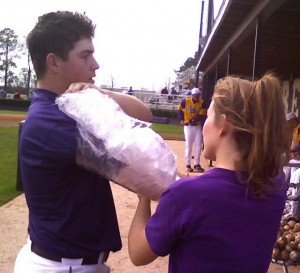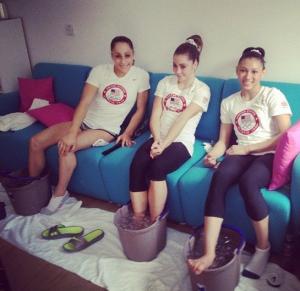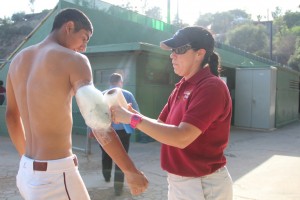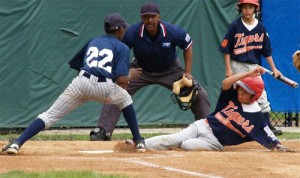Should a pitcher ice after a game?
 (0)
(0)
Like many questions in baseball, this one has stirred many a passionate response. Pitchers, coaches, and even surgeons disagree about applying ice to a pitcher’s arm after a game. Many in baseball will shout in your face if you disagree with them about this. But you can cut through the noise with what you already learned from your biology class in high school or a first aid course. Should a pitcher ice their arm after a game?
The flow of blood helps heal injuries and is essential to recovery. If you cut your arm and no blood flows to that spot, that gash will never close. Inside your body, blood brings oxygen and nutrients to your cells, and that’s what keeps all organs and body tissue working. Ice closes blood vessels (especially the smaller capillaries, which deliver oxygen and nutrients to the cells), and also restricts lymphatic vessels, which carry excess fluids back into your cardiovascular system. So ice will likely increase your recovery time.
 Will icing reduce soreness or pain? Absolutely. It numbs any area why you apply it, so you don’t feel pain or soreness. It makes you feel better. And drinking a sufficient amount of beer or taking drugs (prescription or not) will do the same thing. But numbing is dumbing your ability to feel what your body is saying to you, no matter how you do it. Your body will tell you if you have an injury that needs attention, or if you did something that’s inefficient. Pain is a sign of a problem, but soreness is good because it means you’re using your muscles, challenging them, and you’ll likely get better because of that.
Will icing reduce soreness or pain? Absolutely. It numbs any area why you apply it, so you don’t feel pain or soreness. It makes you feel better. And drinking a sufficient amount of beer or taking drugs (prescription or not) will do the same thing. But numbing is dumbing your ability to feel what your body is saying to you, no matter how you do it. Your body will tell you if you have an injury that needs attention, or if you did something that’s inefficient. Pain is a sign of a problem, but soreness is good because it means you’re using your muscles, challenging them, and you’ll likely get better because of that.
OK, Coach. If you’re right, then why do you see Olympic or professional athletes icing parts of their bodies they use in their sport?
 Great question. To these people, the top one thousand (or hundred) in the world, their sport is their job, their livelihood, their future, and their ticket to fame and fortune. They do whatever they can to perform at their highest level today, and worry about tomorrow when it comes. To perform at those levels, their bodies take a beating getting pushed to the limits. When they training and compete, they typically live with very high levels of pain. They are very competitive, focused beyond what you can imagine, and tolerate real pain much better than you or I. They need help, and ice is the most minor of all intervention.
Great question. To these people, the top one thousand (or hundred) in the world, their sport is their job, their livelihood, their future, and their ticket to fame and fortune. They do whatever they can to perform at their highest level today, and worry about tomorrow when it comes. To perform at those levels, their bodies take a beating getting pushed to the limits. When they training and compete, they typically live with very high levels of pain. They are very competitive, focused beyond what you can imagine, and tolerate real pain much better than you or I. They need help, and ice is the most minor of all intervention.
To be fair, ice can help a bit in the process of healing. It does reduce swelling of inflamed tissue, which could increase lymphatic and blood flow, if timed very carefully. For most athletes, 10 minutes of ice can help reduce inflammation (see the research on icing by Dr. Romain Meeusen of the Free University of Brussels). And many people actually get a “flood of blood” during icing, which is the body’s emergency response to protect the part of the body from necrosis, the premature death of cells of living tissue. However, after about 10 minutes of ice your lymphatic system will effectively stop removing the excess fluid from the area, so it will actually stay engorged longer.
 Another way to think of it is this. If you believe pitching is an injury, then you may well ice afterward. But then you shouldn’t be pitching. If you believe that pitching is a challenging physical activity, then you need to enthusiastically train and prepare for it. Tim Lincecum’s dad taught him that “ice is for injuries, and for your soft drinks.” I agree.
Another way to think of it is this. If you believe pitching is an injury, then you may well ice afterward. But then you shouldn’t be pitching. If you believe that pitching is a challenging physical activity, then you need to enthusiastically train and prepare for it. Tim Lincecum’s dad taught him that “ice is for injuries, and for your soft drinks.” I agree.
Baseball is full of well-meaning people who give advice based on what their coaches have told them over the years. Most trained medical professionals are there to help you recover from injury, not to maximize your performance as an athlete. Every major league pitcher is an expert on what he’s done for himself, but not necessarily what would have given him (or someone else) better performance, longevity, and less pain (check out the NY Times piece written in 2012 by Bobby Ojeda). The choices they make to get and stay playing at their level has little to do with what is best in the long run.
If you’d like some good sound advice for young pitchers, try our Tips From The Coach – Pitching video. It will give you a great source with lots of information on efficient mechanics, what his job is, strategy, grips, and much more. You can see a preview and purchase the Quickstream Online Instant Video here…








